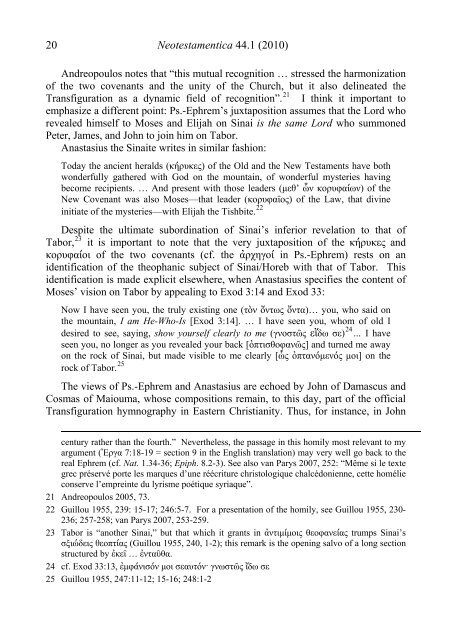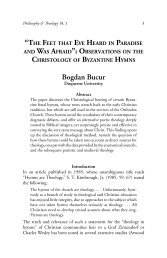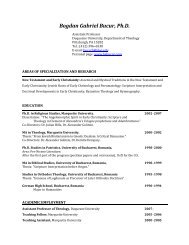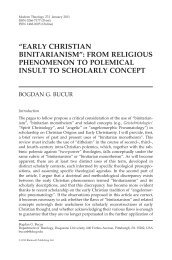Neotestamentica - bogdan g. bucur, ph.d.
Neotestamentica - bogdan g. bucur, ph.d.
Neotestamentica - bogdan g. bucur, ph.d.
You also want an ePaper? Increase the reach of your titles
YUMPU automatically turns print PDFs into web optimized ePapers that Google loves.
20 <strong>Neotestamentica</strong> 44.1 (2010)<br />
Andreopoulos notes that “this mutual recognition … stressed the harmonization<br />
of the two covenants and the unity of the Church, but it also delineated the<br />
Transfiguration as a dynamic field of recognition”. 21 I think it important to<br />
em<strong>ph</strong>asize a different point: Ps.-E<strong>ph</strong>rem’s juxtaposition assumes that the Lord who<br />
revealed himself to Moses and Elijah on Sinai is the same Lord who summoned<br />
Peter, James, and John to join him on Tabor.<br />
Anastasius the Sinaite writes in similar fashion:<br />
Today the ancient heralds (κήρυκες) of the Old and the New Testaments have both<br />
wonderfully gathered with God on the mountain, of wonderful mysteries having<br />
become recipients. … And present with those leaders (μεθ’ ὧν κορυφαίων) of the<br />
New Covenant was also Moses—that leader (κορυφαῖος) of the Law, that divine<br />
initiate of the mysteries—with Elijah the Tishbite. 22<br />
Despite the ultimate subordination of Sinai’s inferior revelation to that of<br />
Tabor, 23 it is important to note that the very juxtaposition of the κήρυκες and<br />
κορυφαίοι of the two covenants (cf. the ἀρχηγοί in Ps.-E<strong>ph</strong>rem) rests on an<br />
identification of the theo<strong>ph</strong>anic subject of Sinai/Horeb with that of Tabor. This<br />
identification is made explicit elsewhere, when Anastasius specifies the content of<br />
Moses’ vision on Tabor by appealing to Exod 3:14 and Exod 33:<br />
Now I have seen you, the truly existing one (τὸν ὄντως ὄντα)… you, who said on<br />
the mountain, I am He-Who-Is [Exod 3:14]. … I have seen you, whom of old I<br />
desired to see, saying, show yourself clearly to me (γνοστῶς εἴδω σε) 24 … I have<br />
seen you, no longer as you revealed your back [ὀπτισθοφανῶς] and turned me away<br />
on the rock of Sinai, but made visible to me clearly [ὧς ὀπτανόμενός μοι] on the<br />
rock of Tabor. 25<br />
The views of Ps.-E<strong>ph</strong>rem and Anastasius are echoed by John of Damascus and<br />
Cosmas of Maiouma, whose compositions remain, to this day, part of the official<br />
Transfiguration hymnogra<strong>ph</strong>y in Eastern Christianity. Thus, for instance, in John<br />
century rather than the fourth.” Nevertheless, the passage in this homily most relevant to my<br />
argument (Ἐργα 7:18-19 = section 9 in the English translation) may very well go back to the<br />
real E<strong>ph</strong>rem (cf. Nat. 1.34-36; Epi<strong>ph</strong>. 8.2-3). See also van Parys 2007, 252: “Même si le texte<br />
grec préservé porte les marques d’une réécriture christologique chalcédonienne, cette homélie<br />
conserve l’empreinte du lyrisme poétique syriaque”.<br />
21 Andreopoulos 2005, 73.<br />
22 Guillou 1955, 239: 15-17; 246:5-7. For a presentation of the homily, see Guillou 1955, 230-<br />
236; 257-258; van Parys 2007, 253-259.<br />
23 Tabor is “another Sinai,” but that which it grants in ἀντιμίμοις θεοφανείας trumps Sinai’s<br />
σξιώδεις θεοπτίας (Guillou 1955, 240, 1-2); this remark is the opening salvo of a long section<br />
structured by ἐκεῖ … ἐνταῦθα.<br />
24 cf. Exod 33:13, ἐμφάνισόν μοι σεαυτόν· γνωστῶς ἴδω σε<br />
25 Guillou 1955, 247:11-12; 15-16; 248:1-2





